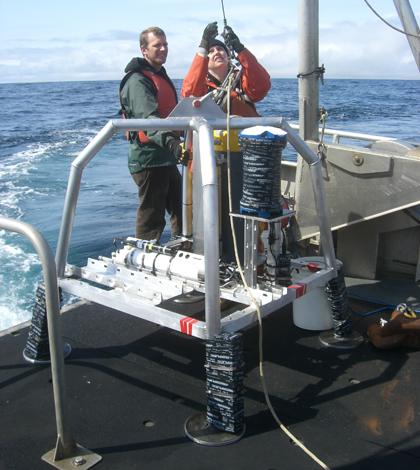Moorings off Oregon coast give insights into dissolved oxygen dynamics

Justin Brodersen and Kim Page-Albins (OSU) in 2009 with instrument mooring before deployment 5 miles offshore of Yachats, Ore. (Credit: Oregon State University)
Each summer, deep ocean currents pull low-oxygen, high-nutrient water up onto Oregon’s coastal shelf. This upwelled water is often implicated in the seasonal hypoxia that has become more frequent in the state’s coastal waters. But a recent study of three summers of data from the ocean floor suggest that the upwelled water may also be the reason that matters aren’t worse.
Though scientists have known about the low-oxygen water making it’s way onto the shelf for decades, the details of what happens once it gets there are foggy.
In an effort to begin addressing the remaining questions–How low does the oxygen go? How long does it last? How much space does it cover?–scientists from Oregon State University’s College of Earth, Ocean and Atmospheric Sciences analyzed data from three upwelling seasons. Instruments moored on the coastal shelf continuously measured variables including dissolved oxygen, salinity, temperature and currents.
The results, published recently in the Journal of Geophysical Research: Oceans, offer a first look at how physical and biological processes interact on the shelf to drive variations of oxygen levels. The data, collected in 2009, 2010 and 2011, have provided insights about the seasonal oxygen variations that weren’t possible with the weekly or monthly ship-based measurements that had been standard.
For one, they were able to simply count up how many days of low-oxygen water there were, said Kate Adams, a graduate research assistant in the College of Earth, Ocean and Atmospheric Sciences and lead author of the study.
“When you do a ship study where you go out maybe every two weeks, you’re just not going to paint the same picture,” Adams said. “You’re not going to be able to say the organisms in the nearby environment were exposed to 90 days of low oxygen.”
The researchers, including primary investigators Jack Barth and Francis Chan of Oregon State, also found that the upwelled water–or source water–wasn’t hypoxic when it arrived on the shelf.
“It’s not below that threshold,” Adams said. “So the water that’s coming up is low in oxygen, but it’s not as low as the measurements we’re making on the shelf.”

Erik Arnesen and David O’Gorman (OSU) in 2011 with the instrument mooring before deployment 5 miles offshore of Yachats, Ore. (Credit: Oregon State University)
That means that the hypoxia that is becoming more common in Oregon’s coastal waters isn’t just a result of the physical process of upwelled water flowing onto the shelf. Though the oxygen is low, the water doesn’t drop into hypoxia until the microbes on the shelf’s near-bottom environment start respiring the oxygen away, Adams said.
To better understand the role of biological processes in driving hypoxia, the study authors also analyzed respiration rates on the shelf. They found that the microbes have the capacity to respire all of the oxygen out of the water column–a surprise, since the dissolved oxygen measurements never dropped to zero. That suggests that the little bit of oxygen that the upwelled water does carry is actually helping stave off anoxia. If it weren’t for the currents continuously ferrying in more offshore water, the trend line of dissolved oxygen over the course of the summer might eventually hit zero.
“That line is basically a tug-of-war between the biology pulling it down trying to get it to zero, and the physics pulling it up by flushing and mixing in higher-oxygen waters,” Adams said.
Adams said developing a better picture of the oxygen dynamics on the shelf will help understand the conditions that organisms–including those in the region’s productive fisheries–are exposed to. That’s good information for fisheries management.
It will also help when it comes to projecting how this region of the ocean will respond to climate change, she said.
“If we can understand now how the physical and biological processes relate, and we can make some projections about how the physics or biology will change, then maybe we can say something useful about how the system will change as a whole in the future.”




0 comments